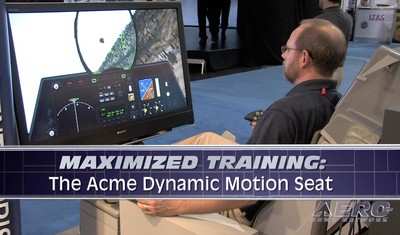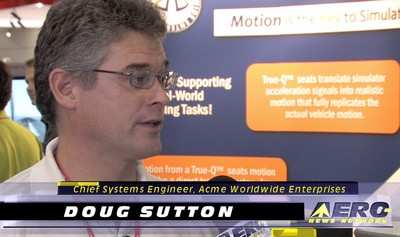Tue, Mar 10, 2009
You know the feeling... that 'seat of the pants' sensation that
cues into the true nature of the flight that you're undertaking...
its an innate part of the true world of flight... and possibly the
most difficult aspect of aviation to simulate.

But... imagine if some company put as much effort into the
recreating the 'seat of the pants' sensations as the sights and
more overt motions associated with flying? Well, imagine no more.
There seems to be a pretty impressive offering available and ANN
got a look at it for the first me at the 2008 I/ITSEC convention
late last year. The ACME Dynamic Motion Seat enhances simulation
training for any type of land, sea, or air vehicle by providing
high-fidelity realistic motion cues to the crewmember -- through an
extremely well-engineered seat.
It's a truly inspired device -- with a phenomenal bag of
tricks...

ACME claims that their DMS is a cost effective method of
providing motion cues to a pilot or other vehicle operator. The
seat accurately simulates the inertial cues experienced in the
operational equipment whether it be an aircraft or other platform.
ACME notes that, "Motion cues are important because they add the
realism necessary for the operator to respond more realistically.
The pilot first receives cues through the tactile and
proprioceptive sensors which precede the information received from
the visual scene. In very stable platforms, the need for motion
maybe minimal. However, in dynamic platforms, prompt attention is
necessary for the operator to maintain control and motion becomes
more contributory to the training. Researchers have drawn a
distinction between disturbance cues (system failures or external
environmental effects) and maneuver cues (controlling the aircraft
or other platform). When there is discontinuity between the visual
scene and what the operator is feeling on his/her body, the overall
effects can be disturbing."
The Dynamic motion Seat offers force cueing with four
degrees-of-freedom using electric servos. These cues provide
realistic kinesthetic (sense of movement) and somatic (skin
pressure) conditions using control algorithms designed to duplicate
the training vehicle environment.

Cues are provided via four independent axis of control using
three axis of movement -- vertical, longitudinal, and lateral.
Independent motions are applied to both the seat bucket as well as
the seat pan. Additionally, the seat back has independent motions
in the surge and sway directions. The surge motion provides the
motion cues for longitudinal acceleration while the sway motion
applies pressure to the trainee's side for lateral acceleration
motion cues. Combined seat motion is used to replicate roll and
pitch acceleration motion cues. A tactile sound transducer placed
in the seat pan to provide high-frequency vibrations.
Even the seat's belts and harnesses are modified to operate with
a drive linkage that can loosen or tighten, as needed, to emulate
positive or negative G-cueing.

More News
Aero Linx: Model Aeronautical Association of Australia MAAA clubs are about fun flying, camaraderie and community. For over 75 years, the MAAA has been Australia’s largest fl>[...]
Touchdown Zone Lighting Two rows of transverse light bars located symmetrically about the runway centerline normally at 100 foot intervals. The basic system extends 3,000 feet alon>[...]
“Discovery and innovation are central to our mission at Virgin Galactic. We’re excited to build on our successful record of facilitating scientific experiments in subor>[...]
How To Get A Story On Aero-TV News/Feature Programming How do I submit a story idea or lead to Aero-TV? If you would like to submit a story idea or lead, please contact Jim Campbel>[...]
Student Pilot Reported That During Rotation, “All Of A Sudden The Back Of The Plane Kicked To The Right..." Analysis: The student pilot reported that during rotation, “>[...]
 ANN's Daily Aero-Linx (05.02.24)
ANN's Daily Aero-Linx (05.02.24) ANN's Daily Aero-Term (05.02.24): Touchdown Zone Lighting
ANN's Daily Aero-Term (05.02.24): Touchdown Zone Lighting Aero-News: Quote of the Day (05.02.24)
Aero-News: Quote of the Day (05.02.24) ANN FAQ: Contributing To Aero-TV
ANN FAQ: Contributing To Aero-TV NTSB Final Report: Cirrus Design Corp SR20
NTSB Final Report: Cirrus Design Corp SR20






